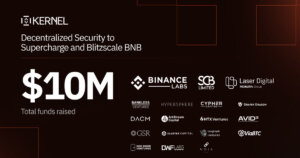 Fund managers: these 3 catalysts could drive greater adoption of Ethereum DeFi
Fund managers: these 3 catalysts could drive greater adoption of Ethereum DeFi Fund managers: these 3 catalysts could drive greater adoption of Ethereum DeFi

Cover art/illustration via CryptoSlate. Image includes combined content which may include AI-generated content.
By most measures, Ethereum’s decentralized finance (DeFi) space is going parabolic.
As reported by CryptoSlate previously, data from DeFi Pulse indicated that the amount of ETH locked in decentralized finance protocols has gained nearly 30 percent in the past 30 days. This means that there is now nearly four percent of all of the assets currently deposited in protocols such as MakerDAO and Compound.
Spencer Noon, the head of DTC Capital, corroborated this growth with his own data.
He shared four pivotal metrics indicating that “breaking out in spectacular fashion.” They are as follows: there is now $4.27 billion worth of assets locked in DeFi by 300,000 users, $10 billion has been traded on decentralized exchanges over the past 12 months, there is $1.42 billion worth of outstanding decentralized loans.
DeFi, an industry that is barely a few years old, is breaking out in spectacular fashion:
1⃣ $4.27B total value locked
2⃣ 300K users w/ 1M in sight
3⃣ $10B trailing 12-mth DEX vol
4⃣ $1.42B debt outstandingOnce again in the crypto world it's all eyes on Ethereum, not Bitcoin. pic.twitter.com/iG7lO2v2hE
— Spencer Noon (@spencernoon) August 4, 2020
Although impressive, fund managers in the space believe that DeFi can grow even faster if these three catalysts/trends are realized.
Developers need to improve scalability, fiat on-ramps, and infrastructure to catalyze faster growth in Ethereum DeFi
Ethereum’s DeFi space has been lauded over recent months for its rapid growth and innovation, but the blockchain is far from perfect. It suffers from the inefficiencies of centralized systems and the shortcomings of early-stage technologies.
This is best epitomized by the cost of gas, which surpassed 200 Gwei during the flash crash on Saturday night.
Pantera Capital’s co-investment chiefs, Joey Krug and Dan Morehead, see value in fixing these issues to “drive further adoption of decentralized finance protocols” and to unlock the “full utility” of these technologies.
The three issues the duo identified are scalability, fiat on-ramps, and infrastructure. Arguably the most important of these three is the former as high costs and slow transaction times would automatically cut down the potential user base of DeFi to a fraction of its original size.
“Major blockchains like Bitcoin and Ethereum can only facilitate 10 transactions per second, basically a non-starter for real-world adoption. This needs to be solved or else transactions will be costly and slow.”
Analysts are confident that these barriers (or at least some of them) can be surmounted.
Andrew Kang, a DeFi analyst and founder of Mechanism Capital, argued that DeFi likely isn’t in a bubble due to the development of the space “hitting an inflection point” with more on-chain liquidity, better development tools, successful case studies, education, and much more.
Needed now more than ever?
Publicly adoptable DeFi protocols are arguably needed now more than ever before.
With yields on financial assets low, access to loans uncertain, and a devaluing U.S. dollar, a move to an alternative system that DeFi can provide may be seen as valuable for many consumers.
Max Bronstein of Coinbase put this well when he recently tweeted:
“The chase for yield in DeFi will only continue to grow exponentially. $3.5 billion USD locked in DeFi, nearly $15 trillion locked in negative yielding debt.”
The chase for yield in DeFi will only continue to grow exponentially.
$3.5 billion USD locked in DeFi, nearly $15 trillion locked in negative yielding debt. pic.twitter.com/d3XOrXvTDg
— Max Bronstein (@max_bronstein) July 24, 2020



 Farside Investors
Farside Investors 































































































